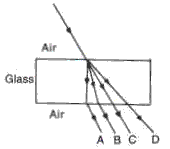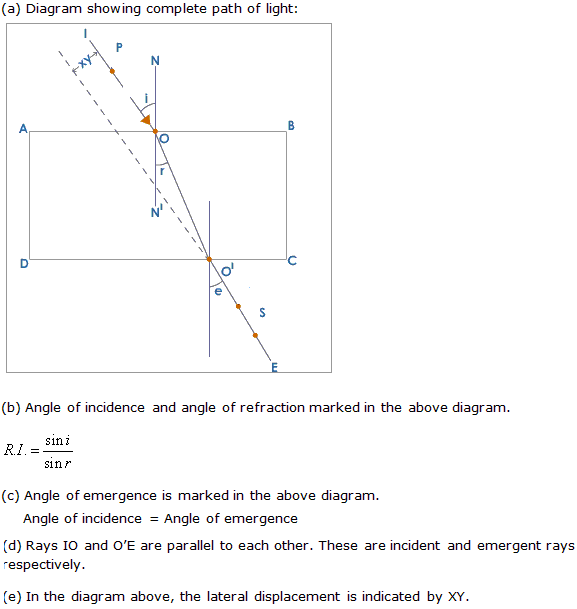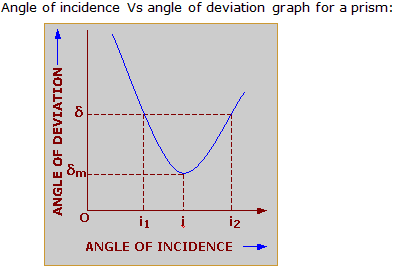Chapter 2.1 - Refraction and Total Internal Reflection of Light Exercise 88
Question 1
What do you mean by the term refraction?
Solution 1
Refraction is the bending of light at the surface of separation, which takes when it passes from one optical medium to another optical medium with different optical densities.
Question 2
How is the refractive index of a medium related to the speed of light in it?
Solution 2
Question 3
For which colour of white light, is the refractive index of a transparent medium the least?
Solution 3
Red colour of white light has least refractive index.
Question 4
For which colour of white light, is the refractive index of glass the most?
Solution 4
Violet colour of white light has highest refractive index.
Question 5
State the principle of reversibility of light.
Solution 5
According to the principle of reversibility, the path of a light ray is reversible.
For e.g. if light travels from air to water along a certain path, then if the path is reversed while travelling from water to air, it will follow exactly the same path.
For e.g. if light travels from air to water along a certain path, then if the path is reversed while travelling from water to air, it will follow exactly the same path.
Question 6
.
index of air with respect to water
index of air with respect to water
Solution 6

Question 7
Define absolute refractive index of a medium.
Solution 7
The absolute refractive index of a medium is defined as the ratio of the speed of e-m radiation in free space to the speed of radiation in that medium.
Question 8
Define the term refractive index of a medium. What do you understand by the statement 'the refractive index of glass is 1.5 for white light'?
Solution 8
When light travels from one medium (air) to another medium (glass), it bends towards the normal. The extent of bending of light depends upon the speed of light (v2) in the second medium, compared to the speed of light (v1) in the first medium. The refractive index of the second medium w.r.t. the first medium (n21) is given by
n21 = Speed of light (v1) in first medium / speed of light (v2) in second medium
The refractive index of glass is typically around 1.5, meaning that light in glass travels at
c / 1.5 = 200,000 km/s. A low value of refractive index also indicates a large critical angle at the glass-air interface.
n21 = Speed of light (v1) in first medium / speed of light (v2) in second medium
The refractive index of glass is typically around 1.5, meaning that light in glass travels at
c / 1.5 = 200,000 km/s. A low value of refractive index also indicates a large critical angle at the glass-air interface.
Question 9
Is dispersion same as deviation?
Solution 9
No, dispersion is not same as deviation.
Question 10
Define angle of deviation.
Solution 10
Angle of deviation may be defined as the angle between original path of incident ray and the path of refracted ray.
Question 11
Name the factors on which the deviation produced by a prism depends.
Solution 11
The value of angle of deviation produced by a prism depends upon:
(i) The angle of incidence
(ii) The material of prism
(iii) The angle of prism
(iv) The colour of wavelength of light used.
(i) The angle of incidence
(ii) The material of prism
(iii) The angle of prism
(iv) The colour of wavelength of light used.
Question 12
State Snell's law.
Solution 12

Question 13
If a light ray does not undergo, refraction at the boundary between two media, the angle of incidence is:
(a) 00 (b) 450
(c) 600 (d) 900
(a) 00 (b) 450
(c) 600 (d) 900
Solution 13
(a) 0o
Question 14
A ray of light passes from air to water. In fig. 39, which of the ray A, B, C and D is the correct refracted ray?


Solution 14
Ray B is the correct refracted ray because a ray of light travelling from air (rarer medium) to water (denser medium) will bend towards the normal.
Question 15
Which of the following has the highest refractive index:
(a) Glass (b) Water
(c) Diamond (d) Ruby
(a) Glass (b) Water
(c) Diamond (d) Ruby
Solution 15
(c) Diamond
Question 16
In the fig. 40, name the ray which represents the correct path of light while passing through a glass block.


Solution 16
The correct path is that of ray 'B'.
Question 17
Does reflection also take place with the refraction?
Solution 17
Yes, reflection also takes place with the refraction.
Question 18
What is the cause of refraction of light?
Solution 18
When a ray of light passes from one medium to another, its direction (except for normal incidence) changes because of change in speed of light. Thus, refraction occurs because light travels with different speed in different media.
Question 19
A ray of light is incident normally on a plane glass slab. What will be the angle of refraction and the angle of deviation for the ray?
Solution 19
The ray of light which is incident normally on the surface separating the two media passes undeviated. Such ray suffers no bending, thus, angle of refraction and angle of deviation is 0o.
Question 20
Name the phenomenon which enables an empty test tube placed inside water shine like a mirror.
Solution 20
The phenomenon is total internal reflection
Question 21
Write the SI unit for refractive index.
Solution 21
Refractive index being the ratio of similar quantities has no units.
Question 22
What do you mean by the statement that the refractive index of diamond is 2.42?
Solution 22

Question 23
Plot a graph between
(i) Angle of incidence versus angle of reflection,
(ii) Sine of angle of incidence versus sine of angle of refraction,
(iii) Angle of incidence versus angle of refraction.
(i) Angle of incidence versus angle of reflection,
(ii) Sine of angle of incidence versus sine of angle of refraction,
(iii) Angle of incidence versus angle of refraction.
Solution 23

Chapter 2.1 - Refraction and Total Internal Reflection of Light Exercise 89
Question 1
In the fig. 41, PO is a ray of light incident on a rectangular glass block.
(a) Complete the path of the ray through the block.
(b) In the diagram, mark the angle of incidence (i) and the angle of refraction (r) at the first interface. How is the refractive index of glass related to the angles I and r?
(c) Mark angle of emergence by the letter e. How are the angles i and e related?
(d) Which two rays are parallel to each other? Name them.
(e) Indicate in the diagram the lateral displacement between the emergent ray and the incident ray.

(a) Complete the path of the ray through the block.
(b) In the diagram, mark the angle of incidence (i) and the angle of refraction (r) at the first interface. How is the refractive index of glass related to the angles I and r?
(c) Mark angle of emergence by the letter e. How are the angles i and e related?
(d) Which two rays are parallel to each other? Name them.
(e) Indicate in the diagram the lateral displacement between the emergent ray and the incident ray.

Solution 1

Question 2
State two factors which affect the critical angle for a given pair of media.
Solution 2
Factors affecting the critical angle are:
(i) The colour (or wavelength) of light.
(ii) The temperature (on changing the temperature of medium, its refractive index changes).
(i) The colour (or wavelength) of light.
(ii) The temperature (on changing the temperature of medium, its refractive index changes).
Question 3
The critical angle for glass-air is 450 for the light of yellow colour. State whether it will be less than, equal to, or more than 450 for (i) red light, (ii) blue light?
Solution 3
The critical angle for a pair of media is:
(i) more than 45o for red light.
(ii) less than 45o for blue light.
(i) more than 45o for red light.
(ii) less than 45o for blue light.
Question 4
Fill in the blanks to complete the following sentences:
(a) When light travels from a rarer to a denser medium, it bends ...........
(b) When light travels from a denser to a rarer medium, it bends ............
(c) The refractive index of glass with respect to air is 3/2. The refractive index of air with respect to glass will be...........
(a) When light travels from a rarer to a denser medium, it bends ...........
(b) When light travels from a denser to a rarer medium, it bends ............
(c) The refractive index of glass with respect to air is 3/2. The refractive index of air with respect to glass will be...........
Solution 4
(a) towards the normal.
(b) away from the normal.
(c) 2/3.
(b) away from the normal.
(c) 2/3.
Question 5
Define the terms critical angle and total internal reflection. State two conditions necessary for total internal reflection to occur. Write down the relation for the critical angle in terms of refractive index.
Solution 5
Critical angle is the angle of incidence in the denser medium for which the angle of refraction in the rarer medium is 90o.
Total internal reflection: When a ray of light travelling from an optically denser medium to an optically rare medium is incident at an angle greater than the critical angle for the pair of media in contact, the ray is totally reflected back into the denser medium. This phenomenon is referred as total internal reflection.
The two necessary conditions for total internal reflection to take place are:
1. The light ray must proceed from denser to rarer medium.
2. Angle of incidence in denser medium should be greater than the critical angle for the pair of media in contact.
Relation between critical angle and r.i.: The critical angle can thus be calculated by taking the inverse-sine ratio of speed of light in denser medium and the speed of light in rarer.

Total internal reflection: When a ray of light travelling from an optically denser medium to an optically rare medium is incident at an angle greater than the critical angle for the pair of media in contact, the ray is totally reflected back into the denser medium. This phenomenon is referred as total internal reflection.
The two necessary conditions for total internal reflection to take place are:
1. The light ray must proceed from denser to rarer medium.
2. Angle of incidence in denser medium should be greater than the critical angle for the pair of media in contact.
Relation between critical angle and r.i.: The critical angle can thus be calculated by taking the inverse-sine ratio of speed of light in denser medium and the speed of light in rarer.

Question 6
What do you mean by the statement 'the critical angle for diamond is 240'?
Solution 6
The critical angle for diamond is 24o; this indicates that diamond has high refractive index of 2.42. This low value of critical angle facilitates total internal reflection of each light ray entering the diamond at its multiple surfaces.
Question 7
Explain the meaning of the term refraction. A ray of monochromatic light is incident from air on a glass slab. Draw a ray diagram indicating the change in its path till it emerges out of the slab.
Solution 7
Refraction is the bending of light at the surface of separation, which takes when it passes from one optical medium to another optical medium with different optical densities.
Ray diagram showing refraction of light through a glass slab:

Ray diagram showing refraction of light through a glass slab:

Question 8
State two uses of a total reflecting prism as a reflector in place of a plane mirror.
Solution 8
Two advantages of using total reflecting prism as a reflector in place of a plane mirror are:
(i) When total internal reflection occurs, the entire light (100%) is reflected back into the denser medium, whereas in ordinary reflection from plane mirror, some light is refracted or absorbed (i.e. reflection is partial).
(ii) Total reflecting prism gives a much brighter image than that obtained by using the plane mirror.
(i) When total internal reflection occurs, the entire light (100%) is reflected back into the denser medium, whereas in ordinary reflection from plane mirror, some light is refracted or absorbed (i.e. reflection is partial).
(ii) Total reflecting prism gives a much brighter image than that obtained by using the plane mirror.
Question 9

Solution 9


0 comments:
Post a Comment